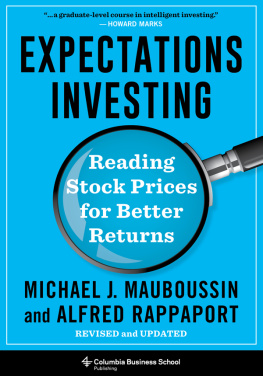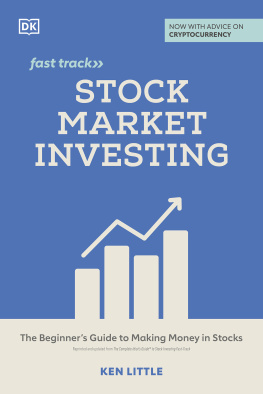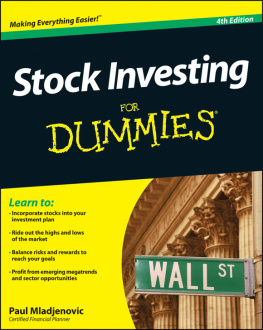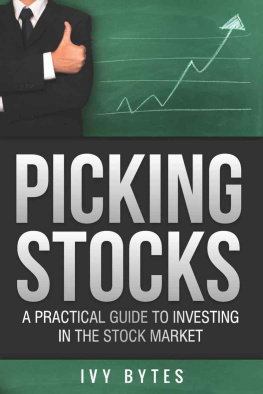Table of Contents
Expectations Investing
Columbia University Press
Publishers Since 1893
New YorkChichester, West Sussex
cup.columbia.edu
Revised and updated edition 2021 Michael J. Mauboussin and Alfred Rappaport
First edition 2001 Harvard Business School Publishing
Paperback edition 2003 Harvard Business Review Press
All rights reserved
EISBN 978-0-231-55484-8
Library of Congress Cataloging-in-Publication Data
Names: Mauboussin, Michael J., 1964 author. | Rappaport, Alfred, author.
Title: Expectations investing: reading stock prices for better returns /
Michael J. Mauboussin and Alfred Rappaport.
Description: Revised and Updated Edition. | New York City: Columbia University Press,
2021. | Revised edition of the authors Expectations investing, c2001.
Identifiers: LCCN 2021015960 (print) | LCCN 2021015961 (ebook) |
ISBN 9780231203043 (hardback) | ISBN 9780231554848 (ebook)
Subjects: LCSH: Investment analysis. | Portfolio management. |
StocksPrices.
Classification: LCC HG4529 .R37 2021 (print) | LCC HG4529 (ebook) |
DDC 332.63/2042dc23
LC record available at https://lccn.loc.gov/2021015960
LC ebook record available at https://lccn.loc.gov/2021015961
A Columbia University Press E-book.
CUP would be pleased to hear about your reading experience with this e-book at .
Cover design: Noah Arlow
To Michelle
To Sharon
Contents
1
The Case for Expectations Investing
PART I
Gathering the Tools
2
How the Market Values Stocks
3
The Expectations Infrastructure
4
Analyzing Competitive Strategy
PART II
Implementing the Process
5
How to Estimate Price-Implied Expectations
6
Identifying Expectations Opportunities
7
Buy, Sell, or Hold?
8
Beyond Discounted Cash Flow
9
Across the Economic Landscape
PART III
Reading Corporate Signals and Sources of Opportunities
10
Mergers and Acquisitions
11
Share Buybacks
12
Sources of Expectations Opportunities
Aswath Damodaran
Some ideas are so powerful, and yet so obvious, that when you hear them or read about them for the first time, your inclination is to whack your head and ask yourself why you did not think of them first. That was my reaction when I first read Expectations Investing, almost twenty years ago. I was familiar with the authors, having read Als writings on shareholder value, bridging accounting and value, as well as Michaels research reports that blended psychology, statistics, and common sense to deliver new insights.
As someone who has worked in the valuation trenches for a long time, the book reframed the question of what a company is worth, from estimating value, given fundamentals, to backing out the fundamentals that are embedded in the market price. While there may be little difference mathematically between the two approaches, that reframing accomplishes two missions. The first is that it cements the link between fundamentals and value by linking what the market is paying for a company to what has to happen, in terms of operating success, for that price to be justified, and makes it easier to act on those assessments. The second is that it forces valuation down to the basics, since as Al and Michael show with their parsimonious models, there are only a few levers that drive value.
As I read the new edition of the book, it is clear that Al and Michael are writing a book for the times that we are in, with much more attention paid to disruption, and the value it creates and destroys, and user/subscriber platforms, which can be exploited for gain and thus provide optionality. The section that goes beyond discounted cash flow valuation to look at real options is a must-read for investors and analysts, since it provides not only a tool that can be used to augment intrinsic value but also practical ways of using it. While the Dominos Pizza example is an excellent illustration of the power of expectations investing in traditional value frameworks, the Shopify case study in the real options chapter can be a game changer if you are wondering how you should be valuing technology companies.
I noticed that the foreword to the first edition of this book was written by Peter Bernstein, a man who represented the very best of investment thinking and writing for many decades. I am no Peter Bernstein, but I believe that if he were still alive, he would be writing an even more enthusiastic foreword than he wrote then.
Stock prices are a treasure of information about the markets expectations of a companys future performance. Investors who properly read market expectations and anticipate revisions increase their odds of achieving superior investment results. Many investors think that they are incorporating expectations when they make decisions, but few actually do so rigorously and explicitly.
The fundamentals of expectations investing are the same as when we published the first version of this book twenty years ago. But plenty in the world is different, making the expectations investing process more useful than ever. Here are some of the most significant changes:
A shift from active to passive investing. Investors have poured trillions into traditional index funds and exchange-traded funds (ETFs) and have withdrawn more than a trillion dollars from actively managed funds since the turn of the century. Index funds and ETFs that track indexes in the United States now have more capital than do funds that pick stocks. Remaining active managers need to embrace the best tools available. We believe that expectations investing provides a path to excess returns.
The rise of intangible investments. In the early 1990s, intangible investments exceeded tangible investments for the first time in the United States. That trend has continued, and companies today invest substantially more in intangible assets than they do in tangible ones. This is important because intangible investments generally appear on the income statement as an expense, while tangible investments are recorded as assets on the balance sheet. Investors have to sort the expenses necessary to support the business from those that are investments in future growth. An understanding of how much a company is investing and whether those investments are likely to create value is essential to anticipating revisions in expectations. Further, scholars have shown that the rise of intangibles has made earnings per share an even less useful measure of corporate performance than it was in the past.
A shift from public to private equity. There are about one-third fewer public companies listed in the United States today than there were in 2001. Over the same time, the venture capital and buyout industries have flourished. Expectations investing provides a framework that investors in both public and private markets can use to improve their chances of finding attractive investment opportunities.
Changes in accounting rules. In the 1990s, stock-based compensation (SBC) consisted primarily of employee stock options that were not expensed on the income statement. Today, SBC is primarily in the form of restricted stock units that are expensed. Both the form of remuneration and how it is accounted for have changed. Further, accounting rules for mergers and acquisitions were revised in 2001, ending the pooling-of-interests method and eliminating goodwill amortization. Expectations investing follows the cash, not earnings, which allows for comparability across companies and over time.










